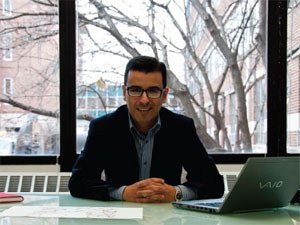Designing smart supply chains: Saif Benjaafar

The shortest distance between two points is a straight line. But what’s the shortest distance among hundreds of points? Distinguished McKnight University Professor Saif Benjaafar draws on knowledge of engineering, economics, computing and business to determine the most efficient way to manage complex supply chains.
“How do we design supply chains with the environmental footprint in mind?” he asks.
A mechanical engineering professor until recently, Benjaafar has spent the past decade getting the Industrial and Systems Engineering program off the ground. Since its launch three years ago, the program has attracted a growing population of students and talented faculty. The program is on its way to becoming the newest department within the College of Science and Engineering. And its evolution reflects Benjaafar’s overall mission as a researcher.
“The program has taken engineering to a higher level,” he says. “It ties in broad societal concerns and challenges. It accounts for the human element.”
The McKnight grant will help him support more students, and offer multi-year research positions that are more attractive to students and post-docs. It will also help him pursue longer-term, riskier projects.
Connecting the dots
Benjaafar's discoveries about everyday business practices may prolong the livability of the planet. His research combines several disciplines to examine the entire product life cycle — raw material extraction, manufacturing, distribution, warehousing and retail.
In the process, he is collaborating with researchers in France, Hong Kong, Singapore, Belgium and China. His team works with faculty from nearly every college on campus, while maintaining ties with industry partners.
He explains the etching on the glass panels in his office make up a “minimum spanning tree,” a supply chain that connects several nodes in the simplest possible way.
In New York, a bottle of wine from France may have arrived at your table at a lower carbon cost than a bottle from California. If the goal is to get the wine to its destination with minimal environmental damage, then where should the winery locate its plants? How should it source grapes? And how should it manage its distribution network?
Benjaafar seeks the best-case-scenario answers. He says there are opportunities to significantly reduce the environmental footprint of supply chains by rethinking their operation — without necessarily making expensive investments or waiting for new technology to mature.
"Human decision making is at the center of how we manage these systems, and ultimately, how we should design them.”
Photos by Andria Peters
Republished with permission from Research @ the U of M, a publication of the Office of the Vice President for Research.
